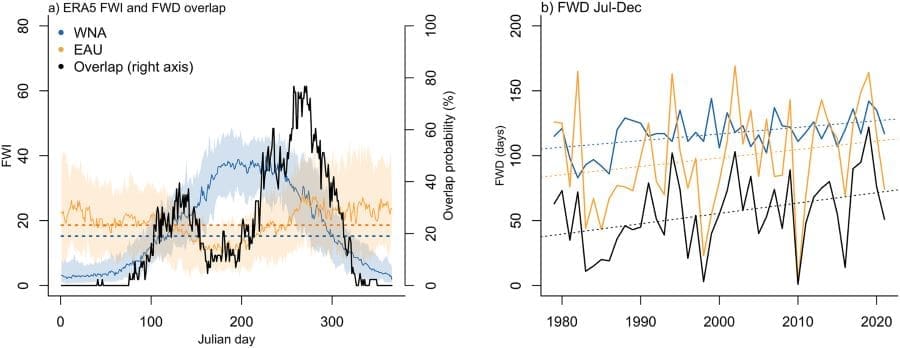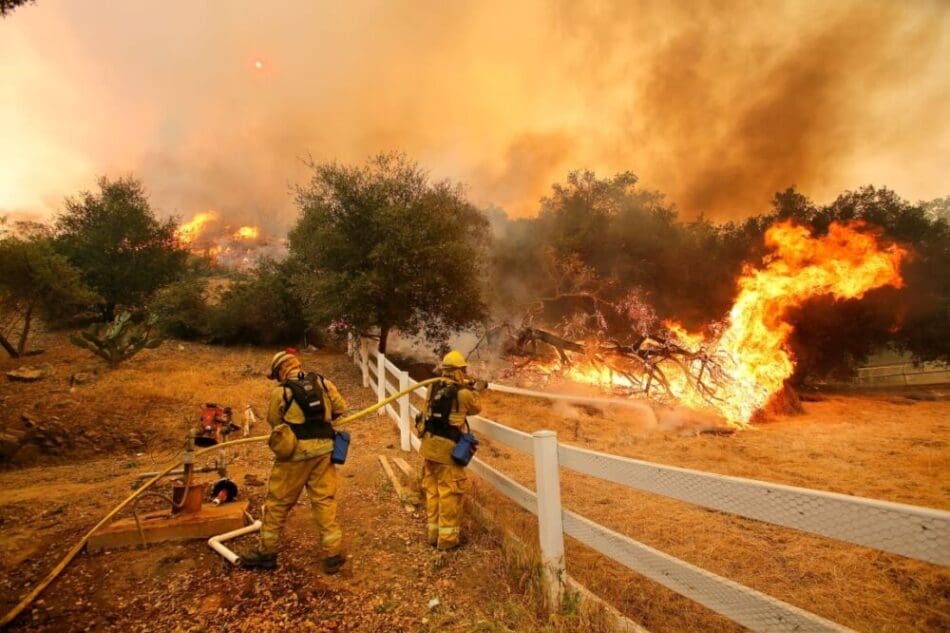Summary:
Climate change is driving a worrying trend: wildfire seasons in eastern Australia and western North America are increasingly overlapping, complicating international firefighting efforts. Researchers from the Helmholtz Centre for Environmental Research (UFZ) and the University of New South Wales found that fire weather — conditions favoring wildfire spread — is aligning more closely between these two regions.
Their findings were published in Earth’s Future.
Using the Canadian Fire Weather Index, the team tracked fire weather days from 1979 onward and found a steady rise in simultaneous high-risk days. The overlap, now most likely between July and December, has been growing by about one day per year for four decades. This shift shortens the traditional window when firefighting personnel and resources can be shared between countries, a practice that has long bolstered wildfire response efforts.
The researchers warn that by mid-century, depending on future global warming levels, overlapping fire weather days could increase by 4 to 29 days annually. Although El Niño typically influences fire weather in Australia and La Niña in North America, climate change is expected to dominate these patterns in the future. The study suggests that international firefighting agreements may need urgent updates to address these challenges.

Climate change increases the risk of simultaneous wildfires
Climate change is increasing the risk of wildfires in many regions of the world. This is due partly to specific weather conditions – known as fire weather – that facilitate the spread of wildfires. Researchers from the Helmholtz Centre for Environmental Research (UFZ) and Australian colleagues have found that fire weather seasons are increasingly overlapping between eastern Australia and western North America. The research team examined the causes of this shift and its implications for cross-border cooperation between fire services in Canada, the US, and Australia.
The west coast of North America and the east coast of Australia have been repeatedly hit hard by wildfires. For example, the January 2025 wildfire disaster in Los Angeles destroyed over 10,000 buildings and claimed 29 lives, according to media reports. The east coast of Australia was hit by one of the country’s most devastating bushfires between September 2019 and March 2020: more than 12 million hectares of forest and bushland burned. Firefighters from Canada, the US, and Australia have supported each other during these disasters and many others.
The international team of scientists set out to examine how the timing of fire weather seasons in the two regions is changing as a result of climate change. The researchers used the Canadian Fire Weather Index (FWI), a meteorological index used worldwide to estimate fire risk. It takes into account rainfall, temperature, relative humidity, and wind speed. They used it to identify fire weather days – days with a high risk of wildfires. Based on observational data, the researchers found that the fire weather days – and thus the risk of wildfires – have been increasingly overlapping since 1979.
The greatest likelihood of overlap – around 75% – occurs between July and December. Overall, the number of simultaneous fire weather days in eastern Australia and western North America has been increasing by one day per year for the past 40 years. This is because the fire season in eastern Australia is starting earlier in spring and overlapping with the end of the fire season on the west coast of North America”, explains Dr Andreia Ribeiro, UFZ climate scientist and lead author, who contributed to the German–Australian research project funded by the German Academic Exchange Service (DAAD).
The team also analysed how the seasonal overlap is likely to develop. They used four climate models, drawing on many simulations to account for uncertainty. The trend is clear: “The number of overlapping fire weather days in western North America and eastern Australia will continue to increase”, says Andreia Ribeiro. Depending on the climate model used and the level of future global warming, the increases could range from 4 to 29 days per year by mid-century.
The overlap depends partly on the variability of the El Niño Southern Oscillation, a system that controls the circulation of the ocean and atmosphere in the equatorial Pacific. Fire weather in eastern Australia is typically linked to El Niño conditions – unusually high sea surface temperatures. This often leads to droughts and heatwaves, among other phenomena. In contrast, fire weather in western North America is more often linked to La Niña conditions – the opposite situation.
“Despite these generally opposing patterns, we found that during strong fire weather overlap, El Niño conditions are especially pronounced in the Central Pacific,” says Andreia Ribeiro. However, the effects of El Niño are expected to be overshadowed by climate change in the medium term. “Climate change is causing global temperature rises and increasing drought in some regions while the El Niño effect is expected to remain largely unchanged,” says Prof Dr Jakob Zscheischler, UFZ climate scientist and co-author.
This poses a challenge for cooperation between US, Canadian, and Australian fire services, which have long supported one another by sharing personnel and aircraft during wildfire emergencies. Until recently, the fire seasons occurred at distinctly different times of the year: on the west coast of North America between June and October and in eastern Australia between October and March.
These gaps provided enough time for teams to assist one another when needed. “But these increasingly overlapping fire weather seasons in the US and Australia are narrowing the window for international cooperation and making it harder to respond quickly to large-scale wildfires,” says lead author Dr Doug Richardson from the ARC Centre of Excellence for Climate Extremes at the University of New South Wales (Australia).
International agreements on firefighting cooperation and national firefighting capacities therefore need to be reviewed. Both Australia and the US will need to strengthen their domestic firefighting capacities in order to reduce reliance on international cooperation.
Journal Reference:
Richardson, D., Ribeiro, A. F. S., Batibeniz, F., Quilcaille, Y., Taschetto, A. S., Pitman, A. J., & Zscheischler, J., ‘Increasing fire weather season overlap between North America and Australia challenges firefighting cooperation’, Earth’s Future 13, 4: e2024EF005030 (2025). DOI: 10.1029/2024EF005030
Article Source:
Press Release/Material by Helmholtz Centre for Environmental Research (UFZ)
Featured image credit: Daria Devyatkina | CC-BY 2.0




